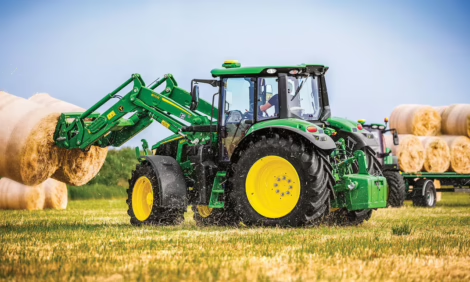



US Breeding Farms Count Cost of Group Housing Sows
US - By the end of 2015, all Cargill's own sows will be group-housed and all of the company's contract farmers must convert from sow stalls by the end of 2017.Pork producers across the US have long kept their sows in small, barred stalls or crates, with so little space they cannot turn around, according to Star Tribune from Dalhart, Texas.
The sows at Cargill’s sprawling hog complex in Dalhart, mill about in pens, snorting and jostling. Some just flop on the concrete floor to rest. It is not Club Pig, but at least the animals get some room.
The move to group sow housing by Cargill and other US pork firms reflects an important shift in thinking about animal welfare, from consumers to large food corporations. Consumers are increasingly interested in how their food is produced – including how animals are treated – while animal rights groups have ratcheted up pressure on the food industry.
The result: restaurant chains, packaged food makers and supermarkets – all big pork buyers – are increasingly requiring suppliers like Cargill to phase out crates and move to group sow housing. At least 60 major US companies have made public declarations for such a shift, including the Twin Cities’ General Mills, Target and Supervalu.
“If you want to be a viable supplier, you respond to the signals your customers send,” said Jeff Worstell, vice president of livestock production for Cargill Pork. Minnetonka-based Cargill intends to phase out all individual stalls from its own hog production system by the end of 2017.
Cost Makes Smaller Producers Reluctant to Change
The shift from stalls to group pens, which could cost $2 billion or more throughout the industry, is divisive within the pork business.
Star Tribune reports that Cargill and its big corporate competitors have deep pockets. But thousands of smaller hog producers are balking at the cost. It is an issue for many producers in Minnesota, the nation’s third-largest hog producing state.
*
"The shift from stalls to group pens ... could cost $2 billion or more throughout the industry"
“Without really knowing how their costs will be recovered, it’s very difficult for farmers to be willing to make the change,” said Dave Preisler, executive director of the Minnesota Pork Producers Association.
Pressure from animal rights groups and ultimately consumers is unlikely to go away, though. A similar sentiment is behind the rise of such products as cage-free eggs and antibiotic-free meat. And it can be seen in the movement in many states to label foods that contain genetically modified ingredients.
“Consumers want more transparency, and it applies to more than animal welfare,” said Amy Sousa, a senior analyst at food market researcher the Hartman Group. “They want to know where their food comes from, what the sources are.”
Cargill's Dalhart Complex
A sow farm is the beginning of a production cycle that ends in bacon, sausage and pork roasts, reports Star Tribune.
Sows are artificially inseminated, then give birth and nurse their offspring until the piglets are weaned. The junior pigs are shipped from sow barns to finishing barns where they are housed in group pens and fattened up before a trip to the slaughterhouse.
In the Texas panhandle’s arid high plains, Cargill owns a complex on 22,000 acres, which will house about 66,000 sows in 143 barns when it is totally built out. Just one row of 26 barns runs nearly a mile.
Cargill is one of the largest US pork producers. About 30 per cent of the pigs it turns into meat are born at company-owned sow operations, particularly the one in Dalhart, or at contract farms. The latter are run by independent operators but they house Cargill-owned sows and piglets.
The other 70 per cent of the pigs processed at Cargill’s packing plants are born to sows not owned by the company, giving it far less control over sow housing for a major part of its supply chain.
At Dalhart, sows still stay for 28 to 42 days in individual stalls – gestation crates – after insemination. That is because bumping around in group pens could cause them to lose embryos, reducing litter sizes. After giving birth, they spend another 20-some days in farrowing pens, small enclosures where sows feed their piglets.
The rest of their time is spent in group pens, each of which houses 42 to 48 sows in a little over 900 square feet of space. Currently, 57 per cent of Cargill’s sows – at its company-owned and contract farms – are housed in group pens, while the rest live almost full-time in gestation crates.
But by the end of 2015, all sows at Cargill-owned barns will be in group housing, the company told the Star Tribune, laying out a timetable for the first time.
All of Cargill’s contract farmers must convert to group housing by the end of 2017.
“We are light years ahead of any other [integrated hog producer],” Mr Worstell of Cargill Pork said.
Several large competitors, including meat giant Smithfield Foods, also have made commitments to group housing. Smithfield was the first major producer to publicly declare a long-term phase-out of gestation crates, back in 2007.
Hormel Foods committed to a phase-out of gestation crates in 2012. The company told Star Tribune that as of 2013, it had installed group housing at 25 per cent of its sow operations, all of which are in three western states. The company, which does not use contract operators, said it expects a 100 per cent conversion by 2018.
Overall, about 20 per cent of US sows are in group sow housing; the rest are in stalls, according to the National Pork Producers Association.
Gestation stalls became common in the 1970s and early 1980s, as hog producers got bigger and moved their animals indoors. The stalls generally measure two feet by seven feet. Canada recently banned the continuous housing of sows in gestation crates, following the European Union.
Some studies have shown that crated pigs will engage in unusual behaviour like biting the stall’s bars. But the biggest issue, to critics, is living space.
“These are 500-pound animals, curious and smart,” Paul Shapiro, vice president of farm animal protection at the Humane Society of the United States (HSUS) told Star Tribune. “To punish them with a type of life sentence of abject misery, it’s just out of step with mainstream American sentiment on how animals should be treated.”
To many hog producers, however, individual stalls are no less humane than group housing.
Dallas Hockman, industry relations vice president at the National Pork Producers Council, said the Humane Society and other animal rights groups have made gestation crates into a “black-and-white” issue.
But animal welfare can be measured in different ways. For animals to produce well, they must be treated well, Mr Hockman said. And sow litter rates, a key productivity gauge, have been going up for at least the past two decades.
“It’s not about right or wrong, it’s about choice,” he said. “The type of housing does not dictate animal welfare.”
Welfare Challenges with Group Housing
Group sow housing has its own animal welfare challenge: fighting and bullying, according to Star Tribune. Such aggressive behavior can cause injuries to weaker pigs and lead to food hoarding by boss hogs.
“Some sows, even with good genetics, are just bullies,” said Temple Grandin, an animal science professor at Colorado State University. “You have to make sure the bully is not knocking the weak sow from the feeder,” said Professor Grandin, who has also worked as a consultant to the livestock industry on animal welfare.
Still, she is partial to group sow housing. She said: “I have problems with keeping an animal in a box where it can’t turn around.” And consumers, when shown the difference between gestation crates and group housing, tend to prefer the latter, Professor Grandin said. “The public doesn’t like sow stalls.”
Going Undercover
Animal rights groups hate sow stalls. They have stepped up their efforts in recent years, often planting their members at hog farms as employees, reports Star Tribune.
The undercover workers have shot videos not only of crated sows, but of such accepted pork industry practices as cutting off piglets’ tails without anesthaesia and killing sick piglets by slamming them against the floor. The group, Mercy For Animals, has infiltrated two large Minnesota hog farms in this way over the past two years.
The Humane Society has been particularly active on the legislative and corporate fronts. It has pushed to get phased-in bans on gestation crates in nine states since 2002, either through legislation or referendums. It has also worked to get food companies – pork buyers – on the group housing bandwagon.
In 2007, Burger King became the first major US restaurant chain to declare it would phase in gestation crate-free pork. In 2012, McDonald’s announced that its pork supply chain would be free of gestation crates by 2022.
After McDonald’s declaration, several dozen companies followed with their own commitments to phase out gestation crates in their supply chains. Cargill, for example, is a big McDonald’s supplier.
“When McDonald’s makes a move in the marketplace, it sets a standard,” said Bob Langert, McDonald’s vice president for sustainability.
Industry Dilemma
Cargill bought the Dalhart pig complex in 2011 for $33 million. Installing group sow housing will cost another $20 million to $25 million. Mr Worstell told Star Tribune that the conversion from sow stalls to pens at an existing facility costs $200 to $600 per sow.
Cargill has money to make the pig housing switch. It is tougher for smaller hog operations, particularly when group housing offers little or no investment return.
*
"Conversion from sow stalls to pens at an existing facility costs $200 to $600 per sow"
“Is the marketplace going to entice producers to cover their costs?” asked Randy Spronk, a veteran hog producer in Pipestone County with interests in three sow barns. “You will incur new debt, without having any equity to show for it.”
Investing in group sow housing is not going to cut a farmer’s operating costs or improve productivity, the usual reasons for investment, producers say. Indeed, unless farmers expand their barns’ footprint, they will have fewer sows since group housing allows animals more space.
“I have to get a return on what I am doing or I’m not going to do it, ” said Mr Spronk, whose operation was the target of a Mercy For Animals video in 2013. “I’m not in this for my health.”
Mr Spronk, a past president of the National Pork Producers Council, said he has received no direction from his pork packers on converting to group housing and he has no plans to do so.
Younger members of his family coming up in the hog business will have to grapple with the issue.
“I’m going to leave that decision to the next generation as to how they want to raise pigs,” Mr Spronk added.
For Cargill, it’s the McDonald’s and Burger Kings of the food world that pushed the switch. The company is going full speed ahead at its barns and trying to get its contract farmers – a major supply source – on board by offering longer-term contracts.
That task may be tough. Farmers who recently invested in new barns will not be keen to tear out crate housing, particularly when it means fewer pigs overall in the same-sized buildings.
Ultimately though, Mr Worstell told Star Tribune, extra costs for producers will be shared by those who eat pork. “Eventually, one way or another, the consumer pays for that cost.”








